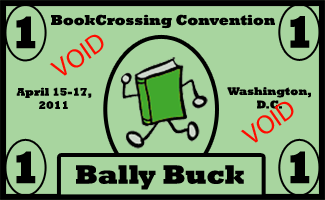Adventures at the Bureau of Engraving and Printing
This post is part 18 of our Wednesday Adventure Series. Each week we will highlight something different in the Washington, D.C., Metro Area, many of which will be options for part of your own BookCrossing Journey. With so many things to see and do, how will you choose?

The Bureau of Engraving and Printing (B.E.P.) is mostly known for printing paper currency used in the United States. However, it’s also responsible for printing Treasury securities, military commissions and award certificates, and security documents and identification cards for a variety of Government agencies. It even printed stamps from 1894 until 2005. What it is not responsible for is coinage, which is produced in Philadelphia and Denver at the United States Mint. There are two locations of the B.E.P.: Fort Worth, Texas (where the 2005 BookCrossing Convention took place) and Washington, D.C. (where the 2011 BookCrossing Convention will take place).

Some fun facts about the B.E.P. and money include:
· A bill (or note) weighs about 1 gram
· The largest denomination note ever printed was a $100,000 Gold Certificate, Series 1934
· The Secretary of Treasury is responsible for choosing the design for the notes
· By law, only portraits of deceased individuals may appear on currency
· A $1 bill’s lifespan in circulation is roughly 42 months, during which time its travels may be tracked at wheresgeorge.com.
· Bally Bucks issued at the 2011 Convention are not legal tender

The B.E.P. is integral to the US, as we use what it produces every day. However, it was not in the original government plan for the country. There was a drain on the supply of coin currency during the Civil War, so in 1861 the government realized another option should be instituted. A private company was hired to print Demand Notes (like IOUs from the Government). The sheets of notes were sent to the Treasury Department where many different clerks cut the notes apart and signed them.
It still took time and many changes to get from that stage to what we have today. The agency went through many names including: National Currency Bureau, Printing Bureau, Small Note Bureau, Currency Department, and Small Note Room. In 1874, congressional legislation made the name “Bureau of Engraving and Printing†stick.
By 1864, the B.E.P. already printed more than just currency and notes. They were responsible for producing Treasury bonds and even passports for the State Department. It wasn’t until the sale of bonds during World War I in 1918 that the power presses at the B.E.P. were redesigned to print eight notes per sheet instead of just four. Currency itself was redesigned in 1929 to standardize size, allow twelve notes to be printed per plate, and combat counterfeiters. Today’s bills are being redesigned slowly to combat modern day counterfeiters; the new $100 bill is just now being released with new security measurements. And today we use systems that can print 32 notes per plate in a process of inking, wiping, and pressing the paper (made of 75% cotton and 25% linen) into the plate where the engraved lines still contain ink.

You can see this process firsthand by touring the Bureau of Engraving and Printing, which is one of your Friday morning early bird add-on choices for the 2011 BookCrossing Convention. Guided tours are 30 minutes long and you will have a chance to visit the gift shop where you can buy anything from shredded money to sheets of uncut currency. You can find out more about the B.E.P. by visiting their aptly-named website: http://moneyfactory.gov.




